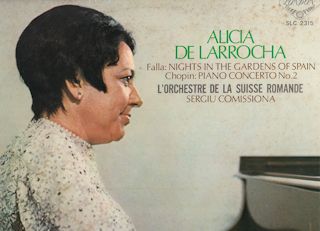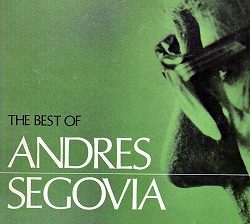|
Spanish Composers and Players
To be honest, I like classical musics. I would like here to write my interest
in something in this field around Iberian Peninsula. But to my regret,
I don't know any composers or players in Portugal now, so I have to confine
it in Spanish artists and works.
As Sevilla stopped on the next day let me recall "The Barber of Seville",
I thought at first this column had to be in the next chapter at Sevilla.
However, I am going to write it here.
It is well known Rossini is an Italian and the composer of this opera buffa.
 I met its overture in the Leonard Bernstein's LP alubum 46 years ago (as
of 2015) at Woolworth near the dormitory during my stay at Pennsylvania
State University for one year. I met its overture in the Leonard Bernstein's LP alubum 46 years ago (as
of 2015) at Woolworth near the dormitory during my stay at Pennsylvania
State University for one year.
The front cover says: Bernstein Conducts Favorite Rossini Overtures, New York Philharmonic --- Il Barbiere di Siviglia.
Well, I begin to write about Falla among the Spanish composers familiar
to me.
I like such ballet musics of Manuel de Falla as "El Amor Brujo" (Love, the Magician) and "The Three Cornered Hat" all right, but I more often listen to "Nights in the Gardens of Spain".
This piano concerto has a clear tone of piano with orchestra, which makes
me feel emotional and see the scene just as the title.
I have 3 CDs and 1 LP. They are:
|
|
|
|
Alicia de Larrocha with L'orchestre de la Suisse Romande, conducted by
Sergiu Comissiona (CD and LP) |
|
|
|
|
|
Martha Argerich with Orchestre de Paris, conducted by Daniel Barenboim
(CD) |
|
|
|
|
|
Guiomar Novaes with Orquesta Sinfonica Pro-musica de Viena, conducted by
Hans Swarowsky (CD) |
|
|
|
|
The following picture is Larrocha's LP, recorded in 1970.

-----
 "Asturius" composed by Isaac Albéniz is one of my favorites too. "Asturius" composed by Isaac Albéniz is one of my favorites too.
It is a piano music, but I met it at the guitar concert of Andres Segovia
in Washington D.C. several decades ago.
My eyes were filled with tears of much emotion.
It caused my interest in Albéniz, not to mention Segovia.
The picture (above right) is the cover of the album "The Collected
Works of Andres Segovia" with 2 LPs, bought in Japan after that travel.
In addition to Albéniz's "Asturius" and "Granada", the album includes such wonderful Spanish musics as "Recuerdos de la Alhambra" and 3 musics by Tarrega, "Spanish Dance in E minor" by Granados, "Minuet" and 2 musics by Sor, "Sonata" by Giuliani, and more than 10 others by other composers.
Several years ago, a friend invited me to the concert of Hiromi Okada,
a Japanese pianist, where I bought his CD "Iberia by Albéniz".
I listen to it at times.
-----
Speaking of Spanish music, I cannot avoid the guitar music after all.
The Spanish composers I recall besides Albéniz are Fernando Sor, Francisco
Tárrega, Enrique Granados and Joaquín Rodrigo in the order of birth.
I often listen to them for a change of pace. By whose Playing?
One of them is Narciso Yepes. He is associated with the movie "Jeux
Interdits" in my mind, which was directed by René Clément, and the
music was in charge of Yepes. The Spanish folk music "Romance de Amor"
became famous by his own play in the movie.
The melody and his play inspired me to learn the guitar when I entered
university, but had to stop it because of the slight fracture of my right
hand.
-----
Now, Joaquin Rodrigo.
Born in 1901 and died in 1999, he is really a man of the 20th century.
In spite of blindness since his childhood, he was a great composer throughout
his life.
He is said not to have played the guitar himself, but he contributed a
lot to the spread of its classical music.
First and foremost, "Concierto de Aranjuez for Guitar and Orchestra".
This music enchants me deeply whenever I listen to it. On a different stage
of Beethoven's musics, it gives me the same hope for tomorrow.
The A side of my LP is this music. John Williams plays the guitar with
the Philadelphia Orchestra conducted by Eugene Ormandy.
Rodrigo composed it at his age of 40. Why is it he, totally blind, named
the music title as "Concierto de Aranjuez"? Aranjuez is the neighboring
place to Madrid.
The B side is also his guitar music "Fantasia para un Gentilhombre"
played by John Williams with the English Chamber Orchestra conducted by
Charles Groves. He composed it by Segovia's request at his age of 54. While
listening, I associate it with baroque-like music " Antiche Danze
ed Arie" composed by Ottorino Respighi, an Italian composer.
Flamenco-guitar music cannot also be detoured either.
When was it I went to the concert of Paco de Lucia somewhere in Tokyo? I became a Paco fan since then.
I'd like to refer to him at the bottom of the next chapter.
------
I do not forget about Pablo Casals.
He was not only the greatest cellist in 20th century but also a composer
and a conductor. According to Wilhelm Furtwängler, one of the greatest
symphonic and operatic conductors of the 20th century, "The player
who has not listened to the cello played by Casals is who does not know
how to play the strings."
I am aware that the music Casals loved and played often is "El Cant
dels Ocells" (The Song of the Birds). It is said to be a traditional
Christmas song and lullaby of his hometown Catalonia.
-----
I have almost forgotton that Pablo de Sarasate is Spanish. He flourished in the 2nd half of 19th century as a violinist and also composed Zigeunerweisen (Gypsy Airs).
That is all of my knowledge about Sarasate. The following passage of WIKIPEDIA
surprised me.
The popularity of Sarasate's Spanish flavour in his compositions is reflected
in the work of his contemporaries. For example, the influences of Spanish
music can be heard in such notable works as Édouard Lalo's "Symphonie
Espagnole" and Max Bruch's "Violin Concerto No. 2" and "Schottische
Fantasie", all of which were dedicated to Sarasate; Georges Bizet's
"Carmen", and Camille Saint-Saëns' "Introduction and Rondo
Capriccioso" and "Violin Concerto No. 3" were written expressly
for Sarasate and dedicated to him.
His brilliant masterly performance had an influence on such composers like
Tchaikovsky and Brahms too. |
|